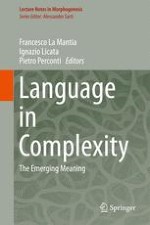2017 | OriginalPaper | Chapter
2. Continuity in the Interactions Between Linguistic Units
Authors : Gilles Col, Rossana De Angelis, Thierry Poibeau
Published in: Language in Complexity
Publisher: Springer International Publishing
Activate our intelligent search to find suitable subject content or patents.
Select sections of text to find matching patents with Artificial Intelligence. powered by
Select sections of text to find additional relevant content using AI-assisted search. powered by
